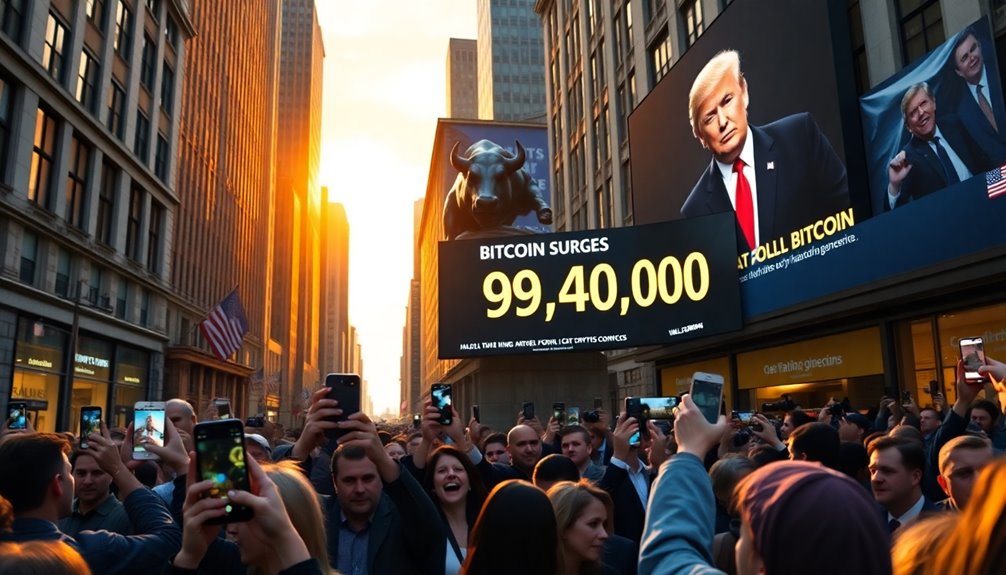Bitcoin just soared past $94,000 thanks to Trump's hints at pro-crypto policies. His potential executive orders aim to tackle de-banking issues and provide regulatory clarity, boosting confidence in the crypto market. With plans to lower taxes on digital assets, Trump envisions the U.S. as the global crypto capital. This shift is causing excitement among investors, as institutional interest in cryptocurrencies continues to grow. As you track Bitcoin's impressive rise, you might find even more insights into how these changes could reshape the digital asset landscape.
Key Takeaways
- Trump's anticipated executive orders are expected to enhance support for digital assets, boosting investor confidence in Bitcoin and other cryptocurrencies.
- The potential repeal of SEC's SAB 121 guideline could create a more favorable environment for blockchain startups, driving demand for Bitcoin.
- Institutional investors are increasingly allocating funds to cryptocurrencies, contributing to Bitcoin's price surge beyond $94,000.
- The formation of a Crypto Council aims to streamline regulations, further encouraging market growth and investment in Bitcoin.
- A significant portion of the crypto community supports pro-crypto candidates, influencing market sentiment and leading to increased prices like those seen with Bitcoin.
Trump's Crypto Policy Impact

As Trump's administration prepares to take the reins, the anticipated shift in crypto policy could significantly reshape the landscape for digital assets in the U.S. You'll likely see executive orders focused on supporting digital assets and blockchain technology right from day one. These policies aim to tackle de-banking issues and create a legal framework that helps crypto companies thrive. With tech leaders like Marc Andreessen and David Sacks shaping these initiatives, expect reduced regulatory uncertainty and a boost in market confidence. This focus on creating a legal framework might even lead to more innovative blockchain applications across various sectors, enhancing America's tech leadership globally. As a result, the crypto market could experience unprecedented growth, with Bitcoin already surging. Furthermore, this supportive stance could make Bitcoin a more attractive option for diversification of portfolios as investors seek to hedge against inflation.
Trump's Crypto Policy Announcement

Trump's upcoming crypto policy announcement is set to transform the digital asset landscape in the U.S., especially with plans for immediate executive orders aimed at addressing key issues like de-banking.
On day one, he'll likely repeal the SEC's SAB 121 guideline, which requires banks to classify crypto assets as liabilities. This move promises regulatory clarity, creating a more favorable environment for blockchain startups. Additionally, the establishment of a Crypto Council will align crypto and AI policy to drive economic growth.
With pro-crypto appointments and a commitment to lower taxes on digital assets, Trump signals a significant shift toward promoting innovation in the crypto space. This proactive approach is part of his broader goal to make the U.S. the global crypto capital.
The market is eager to see how these changes will shape the future of digital currencies.
Crypto Market Volatility Factors

Understanding the factors that influence crypto market volatility is crucial for navigating this unpredictable landscape. Positive and negative news can trigger rapid price changes, while the herd mentality often leads to fear, uncertainty, and doubt among investors. Emotional trading based on fear or greed further exacerbates these price swings. Regulatory announcements can swiftly alter market sentiment, impacting investor decisions. Additionally, supply and demand dynamics play a significant role; a limited supply of certain assets can create sudden price surges when demand increases. Market liquidity is also affected by collective investor reactions, which can amplify the volatility during times of heightened trading activity. Large trades by whales can shift trends due to the market's inefficiency. With continuous trading and an immature market environment, these elements combine to create a volatile and rapidly changing crypto landscape.
Corporate Investment in Cryptocurrencies

With the growing recognition of cryptocurrencies' potential, many corporations are shifting their investment strategies to incorporate digital assets into their portfolios.
Institutional investors show strong sentiment, planning to allocate more than 1% of their assets to digital currencies, viewing them as valuable long-term investments. Companies like MicroStrategy lead the way, utilizing bitcoin for capital preservation and returns.
As the regulatory landscape matures, more firms are adding cryptocurrencies to their balance sheets. Trusted custodians play a crucial role in facilitating these investments, ensuring compliance and security. Additionally, 85% of merchants see crypto payments as a way to attract new customers. Notably, the majority of institutional investors recognize the long-term value of blockchain and digital assets, further incentivizing corporate adoption.
To manage these assets effectively, corporations must implement appropriate risk measures and consider custody solutions, ensuring they're well-prepared for the evolving digital asset ecosystem.
Election Campaigns and Cryptocurrency

As the influence of cryptocurrency grows in the political arena, it's clear that election campaigns are increasingly shaped by the interests of digital asset investors.
The crypto industry has invested over $100 million to support pro-crypto candidates and sway voter opinions. Political Action Committees like Fairshake have spent heavily to unseat anti-crypto politicians, demonstrating their clout. Trump's praise of Bitcoin during his campaign further highlights the growing importance of cryptocurrency in politics.
Pro-crypto candidates, such as Bernie Moreno and Tim Sheehy, have seen significant victories with this backing. Moreover, 73% of crypto owners say a candidate's stance on digital assets will influence their vote.
As more Americans engage with cryptocurrencies, their collective voice is becoming a crucial factor in shaping election outcomes, making it essential for candidates to align with these emerging voter sentiments.
Regulatory Landscape Shifts Ahead

While the regulatory landscape for cryptocurrencies is evolving, significant changes are on the horizon that could reshape the industry.
The incoming Republican administration is expected to eliminate SEC's SAB 121, easing restrictions for banks looking to enter the crypto market. With Paul Atkins as the new SEC Chairman, you might see more favorable regulations. Additionally, the formation of a Crypto Advisory Council aims to establish a transparent regulatory framework, fostering innovation.
On the federal level, the EU's MiCA regulation and OECD's CARF framework are setting new standards for transparency. Anticipated growth in banks' launching crypto-related products is likely to enhance consumer access to crypto services, contributing to a more vibrant ecosystem.
Expect new tax compliance measures, like Form 1099-DA, to enhance reporting.
These shifts could create a more robust environment for digital assets, even amid economic uncertainties.
Frequently Asked Questions
What Is the History of Bitcoin's Price Fluctuations?
Bitcoin's price history shows significant fluctuations driven by various factors.
You'll notice it started at virtually zero in 2009, climbing to $29.60 by mid-2011 before crashing.
In subsequent years, it saw notable highs and lows, such as peaking near $19,188 in late 2017, only to drop below $4,000 in 2018.
How Do Cryptocurrencies Affect Global Economies?
Imagine waking up to find your savings have drastically changed overnight. That's the reality cryptocurrencies create in global economies.
They enhance financial inclusivity, allowing you to access banking through your phone, and enable quicker, cheaper transactions without middlemen. Yet, their volatility can shake investor confidence, making you cautious.
Navigating regulatory landscapes also affects how cryptocurrencies influence economies, as governments balance innovation with oversight.
Ultimately, they're reshaping financial systems worldwide.
What Are the Main Risks of Investing in Bitcoin?
When you invest in Bitcoin, you face several risks.
There's transaction irreversibility, meaning once you send funds, they can't be recovered. You might also lose access to your assets due to forgotten passwords or sending to the wrong address.
Regulatory uncertainties can lead to sudden market shifts, while counterparty risks involve unreliable partners.
Lastly, Bitcoin's high volatility means prices can fluctuate dramatically, potentially resulting in significant financial losses if you sell at the wrong time.
How Does Bitcoin Mining Work?
Think of Bitcoin mining as a high-stakes treasure hunt. You compete with others to find a unique hash that meets the network's target.
Using powerful computers, you increment a nonce to generate these hashes, verifying transactions in the process. Each time you succeed, you create a new block and earn rewards.
However, this treasure hunt is energy-intensive, consuming vast amounts of electricity and impacting the environment, which is a crucial consideration.
What Are the Environmental Impacts of Bitcoin Mining?
Bitcoin mining has significant environmental impacts that you should consider.
It consumes about 0.5% of global energy, resulting in massive carbon emissions—around 22 million metric tons annually. Much of this energy comes from fossil fuels, increasing its carbon footprint.
Additionally, the mining process generates substantial electronic waste and has a considerable water and land footprint.
As you explore Bitcoin, weigh these environmental concerns against its potential benefits carefully.
Conclusion
As the crypto landscape shifts like sand beneath your feet, Trump's hints at pro-crypto policies ignite a wildfire of optimism. With Bitcoin soaring past $94,000, you can feel the pulse of corporate investment quickening, fueling the flames of a new financial era. Keep your eyes peeled; the electoral winds are changing, promising to reshape the regulatory horizon. In this dynamic dance, you hold the key to navigating the exhilarating, yet unpredictable, world of cryptocurrencies.









